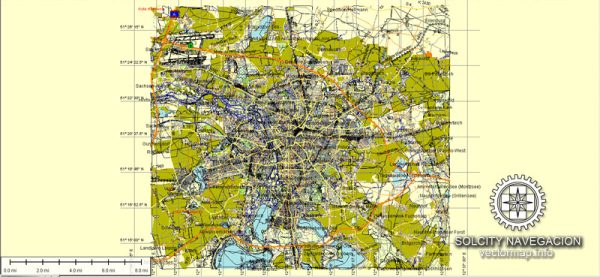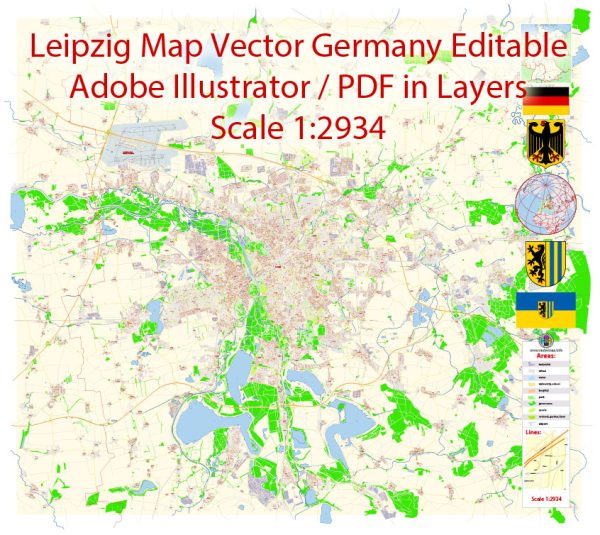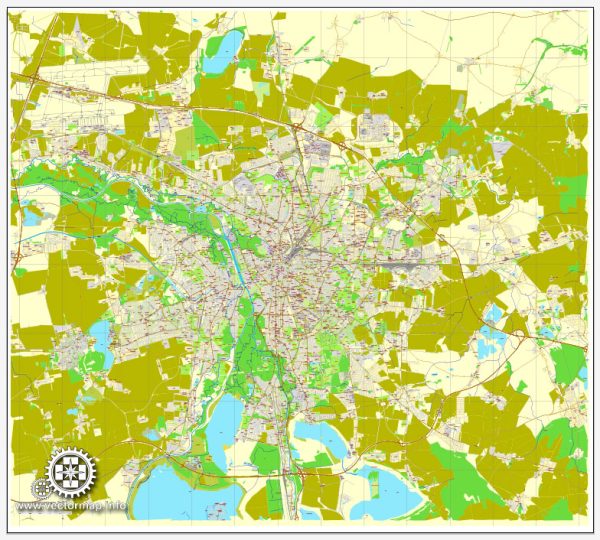Leipzig, located in the eastern part of Germany, has a rich political and transportation history that spans several centuries.
Vectormap.Net provide you with the most accurate and up-to-date vector maps in Adobe Illustrator, PDF and other formats, designed for editing and printing. Please read the vector map descriptions carefully.
Here is a detailed overview:
Political History:
- Medieval Leipzig (12th – 15th centuries):
- Leipzig was founded in the 12th century and quickly became an important trade and cultural center in the Holy Roman Empire.
- In 1485, Leipzig joined the league of six German cities known as the “Messen-Städte” (Trade Fair Cities), which granted them special privileges in trade and commerce.
- Reformation and Trade (16th – 17th centuries):
- The city played a significant role in the Protestant Reformation. In 1519, Martin Luther engaged in a famous debate with Johann Eck in Leipzig.
- Trade fairs in Leipzig continued to grow in importance, attracting merchants from across Europe.
- Napoleonic Wars and Battle of Leipzig (1813):
- Leipzig gained global attention during the Battle of Leipzig in 1813, also known as the Battle of Nations, a decisive conflict in the Napoleonic Wars.
- The defeat of Napoleon’s forces by the coalition of European nations marked a turning point in European history.
- Industrial Revolution and Growth (19th century):
- The 19th century saw Leipzig’s transformation into an industrial city with the expansion of textile and publishing industries.
- The city became a center for intellectual and cultural activities, fostering the development of literature, music, and academia.
- World Wars and Division (20th century):
- Like many German cities, Leipzig suffered during World War II, with significant damage to its infrastructure.
- After the war, Leipzig found itself in East Germany, part of the German Democratic Republic (GDR), during the division of Germany into East and West.
- Peaceful Revolution (1989):
- Leipzig played a pivotal role in the Peaceful Revolution that led to the fall of the Berlin Wall and the reunification of Germany.
- The Monday Demonstrations, which began in Leipzig in 1989, played a crucial role in advocating for political change.
- Post-Reunification (1990s – Present):
- After German reunification in 1990, Leipzig underwent significant economic and infrastructural development.
- It has become a vibrant cultural and economic hub, attracting businesses, artists, and tourists.
Transportation History:
- Trade Routes and Fair Connections:
- Leipzig’s geographical location made it a natural hub for trade routes, contributing to the city’s early economic development.
- The establishment of trade fairs in the Middle Ages solidified Leipzig’s role as a major trading center.
- Railway Development (19th century):
- Leipzig was an early adopter of railway technology, and the first German long-distance railway, the Leipzig-Dresden Railway, was inaugurated in 1839.
- The city’s railway connections expanded rapidly, enhancing its significance as a transportation hub.
- Airport and Aviation (20th century):
- Leipzig/Halle Airport, located in the nearby town of Schkeuditz, has a history dating back to the early 20th century.
- It has grown into one of Germany’s major cargo airports and a key European air freight hub.
- Modern Transportation Infrastructure:
- Leipzig has a well-developed public transportation system, including buses and trams, facilitating easy movement within the city.
- The city is well-connected by road and rail networks, contributing to its accessibility and economic growth.
Leipzig’s political and transportation history reflects its evolution from a medieval trading center to a modern, dynamic city with a diverse cultural and economic landscape. The city’s ability to adapt and reinvent itself has played a crucial role in its enduring significance.




 Author: Kirill Shrayber, Ph.D.
Author: Kirill Shrayber, Ph.D.